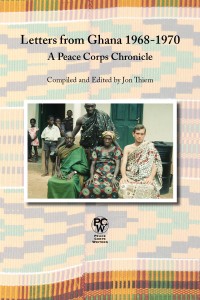NEW BOOK
Letters from Ghana 1968-1970: A Peace Corps Chronicle has been published by Peace Corps Worldwide (2013). The book is compiled and edited by Jon Thiem, Professor Emeritus of English at Colorado State University.

From 1968 to 1970, Thiem was a Peace Corps English teacher in Acherensua, Brong Ahafo Region. Every two weeks, he sent letters and audio tapes to the States describing his experiences. These letters offer raw, immediate impressions of the hard living and cross-cultural labyrinths faced by teachers in rural Ghana. They provide a window into a period of massive “on the ground” intervention in African nations. Between 1961 and 1991, for example, 675,000 Ghanaians had instruction from Peace Corps teachers.
Recent studies have challenged the ideology and effectiveness of humanitarian programs like Peace Corps. The Ghana letters both illustrate and complicate this sort of critique. They show Thiem as a “secular missionary.” They also show him and his colleague “Ohene” Owoahene collecting Akan poetry, an endangered oral tradition. The irony is that Thiem went to Ghana to foster modern thinking, but ended up becoming spellbound by the mythical world of Asante court poetry, which celebrates the bloody deeds and magical powers of ancient kings.
This collection covers a lot of political ground, including U.S. Vietnam policy, dramatic government changes in Ghana, school politics, village power struggles, and controversies about Peace Corps’ mission.
The letters by writers other than Thiem make this book truly multivocal. There are texts by other Peace Corps volunteers and by correspondents from the U.S. The eloquent voices of Ghanaian nationals—teachers, students, politicians, and villagers—are “heard” in the letters and in transcribed audio tapes.
The book has been rigorously edited to make it useful to scholars and students. Among other distinctive features are an incisive introduction and individual commentaries that place the letters in their historical, geographical, and personal contexts. The book includes a map, glossary, timeline, and 29 photos.
Letters from Ghana 1968-1970 is available through the book’s website